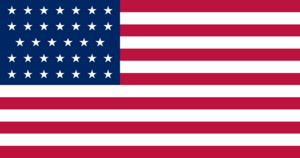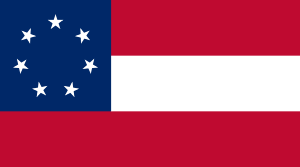Outline of the American Civil War facts for kids
The American Civil War was a major conflict in the United States that lasted from 1861 to 1865. It was a fight between the northern states, known as the Union, and eleven southern states that left the Union to form their own country, the Confederacy.
The main reason for the war was slavery. The Southern states relied heavily on enslaved people for their economy, especially for growing cotton. The Northern states had mostly abolished slavery and wanted to stop its spread. When Abraham Lincoln, who was against the expansion of slavery, was elected president in 1860, the Southern states decided to leave the Union.
The war was a very difficult time for the country, with many battles and a huge loss of life. It ended with the Union winning and slavery being abolished across the entire United States.
Who Fought in the War?
The American Civil War was fought between two main sides:
The Union (The North)
The Union was the United States of America, led by President Abraham Lincoln. Its goal was to keep the country together and end slavery.
- The Union's army was called the Union Army.
- Its navy was the Union Navy.
The Confederacy (The South)
The Confederacy was formed by the eleven Southern states that seceded (left) the Union. They were led by President Jefferson Davis. Their goal was to create an independent country where slavery could continue.
- The Confederacy's army was called the Confederate Army.
- Its navy was the Confederate Navy.
Why Did the War Start?
The American Civil War didn't start overnight. There were many disagreements between the North and South that built up over many years.
Slavery and States' Rights
The biggest issue was slavery. The Southern economy depended on enslaved labor for its large farms. The North, however, had mostly moved away from slavery and many people there believed it was morally wrong.
Another major disagreement was about states' rights. Southern states believed that individual states should have the power to decide on their own laws, including whether to allow slavery. The federal government, they argued, shouldn't interfere.
Key Events Leading to War
- Missouri Compromise (1820): This was an early attempt to balance the number of "free" (no slavery) and "slave" states. It showed how divided the country was.
- Uncle Tom's Cabin (1852): This powerful novel by Harriet Beecher Stowe showed the harsh realities of slavery. It made many Northerners more determined to end it.
- Bleeding Kansas (1854-1859): This was a period of violence in the Kansas Territory. People from both sides (pro-slavery and anti-slavery) fought over whether Kansas would become a free or slave state.
- Dred Scott Decision (1857): The Supreme Court ruled that African Americans, whether free or enslaved, were not citizens. It also said that Congress could not ban slavery in U.S. territories. This angered many Northerners.
- John Brown's Raid (1859): An abolitionist named John Brown tried to start a slave rebellion by raiding a federal arsenal. He was captured and executed, but his actions further increased tensions.
- Election of 1860: When Abraham Lincoln, a Republican who opposed the spread of slavery, was elected president, Southern states felt their way of life was threatened. One by one, they began to secede from the Union.
Life During the War
The war affected everyone, not just the soldiers.
The Emancipation Proclamation
On January 1, 1863, President Lincoln issued the Emancipation Proclamation. This important document declared that all enslaved people in the Confederate states were free. It changed the goal of the war from just preserving the Union to also ending slavery.
Challenges on the Home Front
Life was tough for civilians too.
- New York Draft Riots: In 1863, there were violent protests in New York City against the draft, which forced men to join the army.
- Southern Bread Riots: In the South, food became scarce and expensive, leading to riots where people demanded bread.
Military Forces and Technology
Both sides had large armies and navies, and the war saw new military technologies.
Soldiers and Commanders
- Infantry: Most soldiers were infantry, meaning they fought on foot.
- Cavalry: Soldiers on horseback were used for scouting and quick attacks.
- Artillery: Large cannons were used to bombard enemy positions.
- Famous generals included Ulysses S. Grant and William Tecumseh Sherman for the Union, and Robert E. Lee and Stonewall Jackson for the Confederacy.
New Weapons and Ships
- Minié ball: This new type of bullet was more accurate and deadly than older ones.
- Spencer repeating rifle: This rifle could fire multiple shots without reloading, giving soldiers a big advantage.
- Ironclad ships: These were warships covered in metal armor, making them much harder to sink. The most famous ironclad battle was between the Union's USS Monitor and the Confederacy's CSS Virginia.
- Submarines: The Confederacy even developed an early submarine, the H. L. Hunley, which was used in combat.
Major Battles and Campaigns
The war was fought across vast areas, divided into different "theaters."
Key Theaters of War
- Eastern Theater: This was mainly in Virginia and Maryland, close to the capitals of both sides (Washington D.C. and Richmond).
- Western Theater: This covered areas like Tennessee, Mississippi, and Georgia.
- Trans-Mississippi Theater: This included areas west of the Mississippi River, like Missouri and Arkansas.
Important Battles
Here are some of the most significant battles of the war:
- Battle of Fort Sumter (April 1861): This was the first battle of the war, where Confederate forces attacked a Union fort in South Carolina.
- First Battle of Bull Run (July 1861): The first major land battle, fought near Washington D.C. It showed both sides that the war would not be quick.
- Battle of Antietam (September 1862): The bloodiest single day in American history. The Union victory here gave Lincoln the confidence to issue the Emancipation Proclamation.
- Battle of Gettysburg (July 1863): A huge three-day battle in Pennsylvania. It was a major Union victory and is often seen as a turning point in the war.
- Siege of Vicksburg (May-July 1863): The Union captured Vicksburg, Mississippi, giving them control of the entire Mississippi River. This split the Confederacy in two.
- Sherman's March to the Sea (1864): Union General William Tecumseh Sherman led his army through Georgia, destroying Confederate resources along the way. This was a "scorched earth" tactic aimed at breaking the South's will to fight.
- Battle of Appomattox Court House (April 1865): Confederate General Robert E. Lee surrendered to Union General Ulysses S. Grant here, effectively ending the war.
Who Fought for Each Side?
People from many different backgrounds fought in the Civil War.
- African Americans: Many enslaved people escaped to join the Union army, fighting for their freedom. Free African Americans also joined the Union cause.
- Immigrants: Large numbers of German and Irish immigrants fought for the Union.
- Native Americans: Some Native American tribes fought for both the Union and the Confederacy, often based on their own treaties and conflicts.
What Happened After the War?
The end of the Civil War brought huge changes to the United States.
Reconstruction
The period after the war (1865-1877) is called Reconstruction. The country had to rebuild, especially the South, and figure out how to bring the former Confederate states back into the Union.
- 13th Amendment: This amendment officially abolished slavery throughout the United States.
- 14th Amendment: This amendment granted citizenship to all people born or naturalized in the U.S., including former enslaved people.
- 15th Amendment: This amendment gave African American men the right to vote.
Challenges and Legacy
Despite these changes, the South faced many challenges.
- Jim Crow laws: These laws were passed in Southern states to enforce racial segregation and deny African Americans their rights.
- Ku Klux Klan: This secret society used violence and intimidation to suppress the rights of African Americans.
- Assassination of Abraham Lincoln: Just days after the war ended, President Lincoln was assassinated, which was a huge blow to the nation's healing process.
The American Civil War was a defining moment in U.S. history. It preserved the Union and ended slavery, but its effects on American society, especially regarding race relations, continued for many years.
Images for kids





